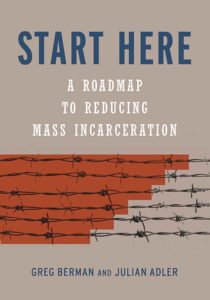Start Here: A Road Map to Reducing Mass Incarceration
Reviewed by David P. Austin
November 1, 2019
 By Greg Berman and Julian Adler. The New Press, 2018. 224 pages. $24.99/hardcover or eBook.
By Greg Berman and Julian Adler. The New Press, 2018. 224 pages. $24.99/hardcover or eBook.
Since the 2010 publication of Michelle Alexander’s landmark book, The New Jim Crow, the issue of mass incarceration has become a hot topic. After years of basically ignoring what has been happening in U.S. prisons (except for the occasional sensationalistic media coverage of prison violence or using prison life as the basis for reality TV shows), everyone from billionaires such as George Soros and Charles Koch to celebrities like Kim Kardashian have championed initiatives to reform the system that has given us the largest prison population on the planet. President Trump has signed into law something called the First Step Act, which, following up on legislation signed by Barack Obama in 2010, has resulted in the release of over 1,000 inmates from the federal prison system. Mass incarceration will no doubt be a major topic of debate during the next presidential campaign.
So lots of people are talking. The media is (sort of) paying attention. But what exactly is being done? And the bigger questions remain: What can be done to change the system we’ve created? And which of these ideas will actually work?
The co-authors of this book work for the Center for Court Innovation, a nonprofit based in New York that deals with justice reform initiatives. They have seen the system from inside and out, and this slim volume, packed with studies, statistics, and anecdotes, lays out the results of their analysis of what doesn’t work—and what has the best potential to work—when it comes to reforming the justice system.
Greg Berman and Julian Adler begin by discussing just who makes up our prison population. The overwhelming majority of prisoners are in state prisons, with local jails housing the second-largest part of the overall population. And, contrary to popular mythology, a significant number of those prisoners are not being held because of nonviolent drug offenses; in fact, more than half have as their primary charge a violent offense. So even if all nonviolent drug offenders were released tomorrow, the authors argue, the United States would still have a huge prison population. And because so many of those prisoners are tagged with the “violent offender” label, garnering public support for prison reform will prove difficult unless it can be shown that there are programs out there that work.
The authors believe they have answers to that concern. The rest of Start Here lays out a series of well-researched, data-driven proposals based on real-life programs that already have worked in communities across the country. They begin by discussing community-based anti-crime and anti-violence programs, such as the Save Our Streets (S.O.S.) program in Brooklyn. They go on to consider courthouse-based initiatives, the use of risk assessment in making decisions regarding sentencing (an admittedly controversial idea), the elimination of incarceration for those who are awaiting trial (a surprisingly large percentage of the local jail population falls into this category), drug courts, and the use of cognitive behavioral therapy to treat violent offenders. They conclude with an in-depth look at the remarkable progress being made by the state of Georgia, as an example of a statewide initiative that seems to be working.
The authors’ thesis is best summed up thus:
We need to channel both Mr. Spock and Dr. Leonard “Bones” McCoy from Star Trek if we are to reduce the use of incarceration. We need a Spock-ian commitment to rational decision-making that moves away from bias and emotion. . . . But, like Bones, we also need to recognize the fundamental humanity—and capacity for change—of every person in the justice system, no matter what side of the law they happen to be on.
Friends who read that quote carefully might agree with me that it seems to express a very Quakerly philosophy. Those who are interested in doing more than just talking about mass incarceration will want to read and discuss this book.
1 thought on “Start Here: A Road Map to Reducing Mass Incarceration”
Leave a Reply
Comments on Friendsjournal.org may be used in the Forum of the print magazine and may be edited for length and clarity.



Someone picked up this op-ed piece I wrote on prison sentencing reform and posted it at this popular resistance site:
https://popularresistance.org/prison-sentencing-as-if-budgets-mattered/
It was originally published in Oregon Public Empowerment News (OregonPEN.org)
I haven’t heard any objections to the idea other than “Nobody does that” — which may be why we’re bursting to the seams with incarcerated people.